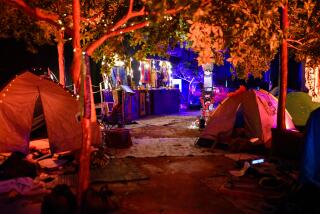Rock in a Hard Place
- Share via
Newport Beach, April 1. Preparations are quickly coming together for the 450-mile walk from Moscow to Leningrad when International Peace Walk president Allan Affeldt and his staff conceive the idea of a Fourth of July rock concert in Moscow featuring American and Soviet artists. Says Affeldt: “We talked about raising a million dollars, getting production and artists--all of it in a month. It seemed ridiculous. But then we said: ‘Wouldn’t it be wonderful?’--which turned into ‘Let’s give it a try.’ ”
Los Angeles, April 15. Maureen O’Sullivan, the walk’s publicist, helps Affeldt contact rock impresario Bill Graham to request his expertise in planning the concert. Graham’s reaction: “I swore after last year I was declaring a moratorium on benefit concerts.” In the past 18 months Graham had produced three major benefits (Live Aid, the Amnesty International Tour and the Concert Against Crack) while juggling his commercial commitments. During the same period, his offices were firebombed. He wants to slow down. But Affeldt is offering him an opportunity reborn. Nine years before, Graham had planned a similar concert in Leningrad. After getting every visa and permit required, he had been turned back at the Finnish border.
San Francisco, April 20. Graham agrees to handle logistics for the show but nothing more.
Moscow, May 3. Steve (Killer) Kahn, logistics expert for Bill Graham Productions, arrives in Moscow.
Los Angeles, May 19. Affeldt is having no success getting bankable stars or the necessary $1 million. Graham agrees to host a luncheon for industry people at L’Hermitage. Affeldt is in business suit and running shoes at one end of the table. On his left is Lynne Littman, director of the anti-nuclear-war film “Testament”; to his right, Dr. Robert Gale, the UCLA bone-marrow specialist of Chernobyl fame. Also present are actor Dennis Weaver, agent Peter Asher, singer Kris Kristofferson, producer / director Tony Bill and Graham. During dessert, Affeldt rises and explains the importance of the concert. It will be the first joint rock concert between the United States and the Soviet Union; it will be broadcast live to millions of Soviet citizens over television and radio, then played later on American TV. Graham encourages each person present to use his or her influence to pull in a superstar.
San Francisco, May 22. The deadline arrives without stars or money. Graham now offers to get the acts. The deadline is pushed to May 29.
San Francisco, May 29. Graham offers to go out and get the money. He calls on past benefit supporters and comes up with half a million dollars.
Newport Beach, June 1. Anxiety is high among the staff members at International Peace Walk Inc. The Soviet Peace Committee, with which they have been arranging the walk and concert, has not answered telexes for two weeks.
Moscow, June 3. Affeldt, Graham and Kahn meet with G. Borovik, head of the Soviet Peace Committee. The Soviets agree to a concert; the problem is finding an arena. Kahn and Graham suggest the larger of the two Dynamo soccer stadiums, which holds 60,000. The Soviets oppose this because it will ruin the field during soccer season.
Leesburg, Va., June 8. Affeldt begins an orientation camp for the 220 walk participants. Less than a week is left to firm up the acts, raise another half a million dollars and talk the Soviets into use of the stadium. Miraculously, it all comes together; the concert is a go. James Taylor and Santana are confirmed to appear, as are the Soviet rock group Aquarium and singer Alla Pugachova. But only then does the nightmare begin for Kahn. Because the Soviets have never staged a concert of this size, equipment is not available. The stage is in Hungary; the lights are in London. Sound equipment has to come from Germany; the food from Sweden.
Moscow, June 17. Although arrangements are supposedly complete, the Soviet Peace Committee vacillates about the date and location. A brief crisis ensues, but the Soviets decide the concert can go on as planned if it is moved to the smaller Dynamo stadium, which accommodates 20,000. Graham, Kahn and Affeldt agree to this condition and hold their collective breath at the fragility of the negotiations.
More to Read
Sign up for Essential California
The most important California stories and recommendations in your inbox every morning.
You may occasionally receive promotional content from the Los Angeles Times.










